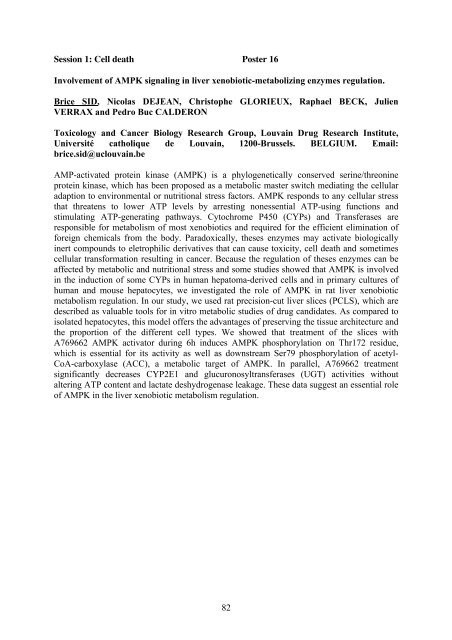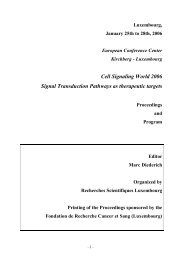Abstract book (download .pdf file) - Redox and Inflammation ...
Abstract book (download .pdf file) - Redox and Inflammation ...
Abstract book (download .pdf file) - Redox and Inflammation ...
Create successful ePaper yourself
Turn your PDF publications into a flip-book with our unique Google optimized e-Paper software.
Session 1: Cell death Poster 16<br />
Involvement of AMPK signaling in liver xenobiotic-metabolizing enzymes regulation.<br />
Brice SID, Nicolas DEJEAN, Christophe GLORIEUX, Raphael BECK, Julien<br />
VERRAX <strong>and</strong> Pedro Buc CALDERON<br />
Toxicology <strong>and</strong> Cancer Biology Research Group, Louvain Drug Research Institute,<br />
Université catholique de Louvain, 1200-Brussels. BELGIUM. Email:<br />
brice.sid@uclouvain.be<br />
AMP-activated protein kinase (AMPK) is a phylogenetically conserved serine/threonine<br />
protein kinase, which has been proposed as a metabolic master switch mediating the cellular<br />
adaption to environmental or nutritional stress factors. AMPK responds to any cellular stress<br />
that threatens to lower ATP levels by arresting nonessential ATP-using functions <strong>and</strong><br />
stimulating ATP-generating pathways. Cytochrome P450 (CYPs) <strong>and</strong> Transferases are<br />
responsible for metabolism of most xenobiotics <strong>and</strong> required for the efficient elimination of<br />
foreign chemicals from the body. Paradoxically, theses enzymes may activate biologically<br />
inert compounds to eletrophilic derivatives that can cause toxicity, cell death <strong>and</strong> sometimes<br />
cellular transformation resulting in cancer. Because the regulation of theses enzymes can be<br />
affected by metabolic <strong>and</strong> nutritional stress <strong>and</strong> some studies showed that AMPK is involved<br />
in the induction of some CYPs in human hepatoma-derived cells <strong>and</strong> in primary cultures of<br />
human <strong>and</strong> mouse hepatocytes, we investigated the role of AMPK in rat liver xenobiotic<br />
metabolism regulation. In our study, we used rat precision-cut liver slices (PCLS), which are<br />
described as valuable tools for in vitro metabolic studies of drug c<strong>and</strong>idates. As compared to<br />
isolated hepatocytes, this model offers the advantages of preserving the tissue architecture <strong>and</strong><br />
the proportion of the different cell types. We showed that treatment of the slices with<br />
A769662 AMPK activator during 6h induces AMPK phosphorylation on Thr172 residue,<br />
which is essential for its activity as well as downstream Ser79 phosphorylation of acetyl-<br />
CoA-carboxylase (ACC), a metabolic target of AMPK. In parallel, A769662 treatment<br />
significantly decreases CYP2E1 <strong>and</strong> glucuronosyltransferases (UGT) activities without<br />
altering ATP content <strong>and</strong> lactate deshydrogenase leakage. These data suggest an essential role<br />
of AMPK in the liver xenobiotic metabolism regulation.<br />
82




